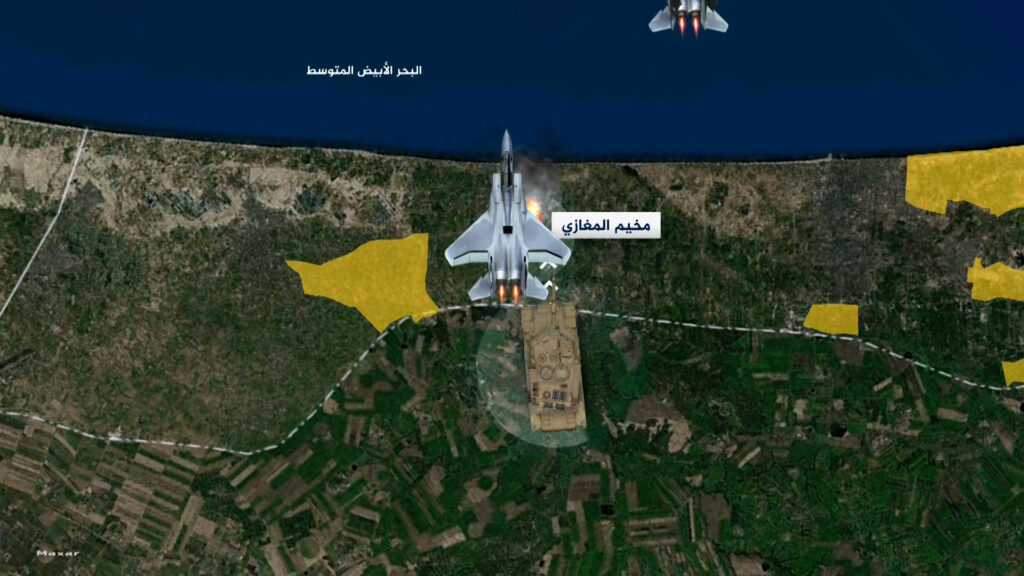It is one of the smaller camps in the Gaza Strip. It was established in 1949 after the Nakba of 1948 in the site of the historic village of Dathen in the middle of the Strip. The origins of its residents come from villages located in southern and central Palestine. The camp suffers from overcrowding, limited space, high unemployment rates, poverty, and a lack of housing.
Origin and establishment
Al-Maghazi camp was established in 1949, immediately after the Palestinian Nakba. It is one of the smallest camps in the Gaza Strip, yet it suffers from a high population density.
The camp was established on the site of the historic village of Dathen, which is located east of Salah al-Din Street, and on its lands was a British army camp during World War II.
The origins of its residents come from the villages located in southern and central Palestine, including Beersheba, Ashdod, Beit Daras, and other lands and villages that were controlled by the occupation and the displacement of their original citizens.
The camp residents were forced to build additional, random floors to accommodate their families, in difficult and unsuitable living conditions.
The camp includes 5 school buildings, 9 facilities belonging to the United Nations Relief and Works Agency for Palestine Refugees (UNRWA), and one health center.
the site
Al-Maghazi camp is located in the middle of the Strip, and is bordered by Al-Bureij camp to the north, the town of Al-Masdar to the south, the city of Deir Al-Balah to the southeast, and the town of Al-Zawaida to the west to the northwest.
The location of Al-Maghazi camp is distinguished by its passage through the Green Line – which separates Lands 48 and Lands 67 – at a distance of 1.5 kilometers to the northeast, and is located halfway between the Green Line and the Mediterranean coast.
Area and population
The area of Al-Maghazi camp is estimated at approximately 559 dunums (a dunum is equivalent to a thousand square metres), but overcrowding led to its area gradually expanding until it reached 3,050 dunums on the western, northern and southern sides, at the expense of neighboring agricultural lands.
Al-Maghazi camp constitutes about 6% of the area of the Central Governorate, and is considered one of the highest population density camps due to its small area. Its population in mid-2023 reached about 31,329 refugees, according to the UNRWA website.
The camp’s population in 1967 was about 8,167 people, while in 1987 it was 10,916 people, according to UNRWA statistics.
The economic activity
The residents of Al-Maghazi camp allocate most of the area to agriculture, which is considered one of the most important activities practiced by the residents, especially those that depend on wells, springs, and rain. The camp is famous for its citrus crops, olives, vegetables, and other crops.
The camp also includes a group of factories, chicken farms, and some small companies specialized in food manufacturing. However, there are not sufficient job opportunities for all citizens in the camp.
Maghazi camp management
The camp is administratively affiliated with the Central Governorate, and its affairs are managed by a municipal council that was established according to the administrative division approved by the Ministry of Local Government in 1996, in addition to UNRWA, which provides many health and educational services.
Camp problems
Al-Maghazi camp suffers from overcrowding and lack of space, forcing its residents to build their homes close to each other, or to build additional floors randomly without an organized design, which negatively affects health conditions.
The camp’s streets are made up of twisting alleys and corridors, some of which were forcibly expanded at the expense of some homes. They also became channels for wastewater, which led to the formation of small ponds in which insects that transmit diseases and epidemics nest.
Access to clean water is one of the most prominent problems faced by the camp residents, in addition to the power outage, which negatively affects the availability of basic services, especially health services, water and sanitation.
The decline in UNRWA’s budget has affected the health conditions in Al-Maghazi camp, in addition to the reduction of other services, so that UNRWA no longer meets all the needs of refugees.
The Israeli wars on the besieged Strip have led to huge losses despite the reconstruction. Successive wars spoil reforms, prevent recovery, and cause great damage to homes and infrastructure.
The people of Al-Maghazi camp suffer from high rates of unemployment, poverty, and lack of housing.




